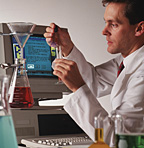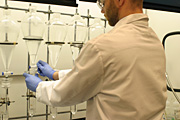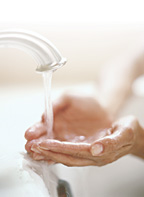Over the last 15 years, a regulatory framework has been developed across the U.S. and Canada for controlling the leaching of lead and other contaminants from plumbing and other products used in municipal water distribution systems. This regulatory framework is based on NSF/ANSI Standard 61: Drinking Water System Components-Health Effects. Most American and Canadian plumbing product standards now reference NSF 61. The standard is also referenced directly in the Uniform Plumbing Code, the International Plumbing Code and the National Standard Plumbing Code. Forty-four U.S. states and three Canadian provinces require municipal drinking water system components to comply with the requirements of the standard. However the enforcement of this standard varies widely based on product type. While it is a safe bet that the majority of faucets and plastic pipe sold in the U.S. will not leach harmful amounts of lead or other contaminants, the same cannot be said for all types of plumbing products.

Development of NSF 61
Prior to 1988, the U.S. EPA Additives Advisory Program for drinking water system components provided the regulatory framework and approval processes for inclusion of plumbing products and components into the water distribution systems across the United States. In 1984, the U.S. EPA published an RFP for the purpose of expanding the process from a registry of product information into a product evaluation and manufacturing inspection program. A consortium led by NSF International (NSF), including the American Water Works Association and its Research Foundation, the Association of State Drinking Water Administrators, and the Conference of State Health and Environmental Managers, was awarded the contract to develop the standard.
Based on the cooperative work of this consortium, NSF/ANSI Standard 61: Drinking Water System Components-Health Effects was published in 1988 with the intent to establish minimum requirements for the control of potential adverse human health effects from products that contact drinking water. NSF also launched a product certification program for NSF 61 this same year. Today, several certification organizations, including NSF, are accredited by the American National Standards Institute (ANSI) and/or the Standards Council of Canada (SCC) to provide third party certification of products to NSF 61. Over 20,000 products are currently certified.
Scope of the Standard
Standard 61 is intended for voluntary use by certifying organizations, utilities, regulatory agencies and/or manufacturers as a basis of providing assurances that adequate health protection exists for covered products. The products covered by this standard include:
- Pipes and Related Products (including pipe, hose, fittings)
- Protective and Barrier Materials (including cements/coatings)
- Joining and Sealing Materials (including gaskets, adhesives, lubricants)
- Process Media (including carbon, sand, zeolite, ion exchange media)
- Mechanical Devices (including water meters, in-line valves, filters, process equipment)
- Mechanical Plumbing Devices (faucets, drinking fountains, and components)
- Potable Water Materials (non-metallic materials)
NSF/ANSI Standard 61 includes criteria for evaluating products to ensure that they do not leach contaminants that would be a health concern into the water. These contaminants include those regulated by the U.S. EPA and Health Canada, as well as any other non-regulated compounds that may be of concern. For regulated contaminants, the maximum permissible level is established by the U.S. EPA and Health Canada.
For non-regulated contaminants the maximum allowable level is established based on existing toxicology data and risk assessment studies, and the level at which the contaminant leached into the water. This process of setting maximum levels is defined in NSF/ANSI Standard 61, Annex A. This annex defines the toxicological review and evaluation procedures for the evaluation of substances imparted to drinking water through contact with drinking water system components. It is intended to establish the human health risk, if any, of the substances imparted to drinking water under the anticipated use conditions of the products. Maximum permissible contaminant levels in NSF 61 are defined as the Total Allowable Concentration (TAC) and the Single Product Allowable Concentration (SPAC).
Endpoint devices like faucets and drinking water fountains are taken through a three-week exposure protocol using specially formulated exposure water that contains high levels of alkalinity, which is especially aggressive for lead. Samples of water are analyzed after 16-hour exposures at nine sample points throughout the three-week period. A statistical calculation of normalized lead leach concentrations yields a Q value which must be equal to or less than 11 ppb. The normalized exposure concentrations from the last day of testing must meet the SPAC for each contaminant other than lead.
In-line devices like ball valves and water meters are taken through a three-week exposure period that utilizes three different exposure waters. Metallic products are tested in two sets. One is exposed to pH 5 formulated water that is especially aggressive for copper, chromium, nickel and antimony. A pH 10 exposure water is used which is aggressive for lead, arsenic, barium, beryllium, boron, cadmium, mercury, selenium and thallium. Non-metallic components are tested using a pH 8 exposure water, which is more aggressive for the non-polar organic compounds. Normalized contaminant concentrations are required to meet the TAC (15 ppb for lead) for static conditions and the SPAC (1.5 ppb for lead) for flowing conditions.

NSF Product Certification to NSF/ANSI Standard 61
NSF International is accredited by ANSI and the SCC to the requirements of ISO Guide 65 as a product certification organization for NSF/ANSI Standard 61. NSF currently has certified over 16,000 products to NSF 61. Listings of NSF-certified products are updated daily at www.nsf.org.The NSF certification process requires a disclosure by the manufacturer of all water-contact materials in the product, and a disclosure by the manufacturer's material suppliers of all chemical ingredients in the materials. NSF toxicologists perform a formulation review of each water-contact material to determine any possible ingredients, contaminants or reaction by-products that may potentially leach from the material into drinking water. This formulation review then determines the battery of chemical analyses that will be performed on a particular material.
NSF then conducts an inspection of the production facility to verify the product formulation and production process, and to ensure adequate quality control procedures are in place to prevent the use of unauthorized materials. Product samples are collected during the inspection and sent to NSF laboratories to be tested to the appropriate exposure protocol of NSF/ANSI Standard 61.
Contaminant concentrations are determined from chemical analyses of the exposure water samples and then evaluated by a toxicologist to the pass/fail criteria described later in this article. Products that meet the requirements of the standard are then certified and appear in NSF listings. Listed production facilities are then subjected to unannounced annual inspections by NSF auditors to ensure that certified products are made according to the authorized formulations and processes. Products are collected on a routine basis (typically once annually) for retesting.
Regulatory Requirements
All the major model plumbing codes in North America (IPC, UPC, NSPC, NPC) either reference NSF 61 directly or reference product standards that in turn reference NSF 61 for health effects. There are notable exceptions, however.The International Plumbing Code references NSF 61 for pipe, fittings and endpoint devices like faucets and drinking fountains. However, the code is unclear regarding the application of NSF 61 to in-line devices such as ball valves, gate valves and backflow preventers.
The Uniform Plumbing Code references NSF 61, but does not directly tie referenced standards to specific product types in the body of the standard. This causes confusion among plumbing inspectors, and for this reason, NSF has started to offer certifications to the UPC through the NSF U.P. Code Mark.
The National Plumbing Code of Canada does not specifically reference NSF 61 despite repeated attempts by Health Canada to have it included. The NPC does indirectly reference NSF 61 through CSA product standards, which reference NSF 61.
Enforcement also varies widely based on product type. The U.S. Safe Drinking Water Act amendments of 1996 required endpoint devices to comply with the lead leach requirements of NSF 61. This resulted in faucets and drinking fountains being required by federal law to meet the requirements of NSF 61 at the point of sale. This caused major retailers to start to require third party certification for faucets to NSF 61, and as a result, the vast majority of faucets sold in the U.S. today will have NSF 61 certification. However, those same retailers that only sell NSF 61-certified faucets will sell ball valves and gate valves with no certification. Many of these in-line devices are made from higher lead alloys that would not comply with NSF 61 requirements.
The same situation exists for pipe and fittings. NSF/ANSI Standard 14: Plastic Piping System Components and Related Materials was first developed in the 1960s. This standard had its own health effects criteria for plastic pipe and fittings prior to the development of NSF 61. When NSF 61 was developed in 1988, NSF 14 was revised to reference it. Since NSF 14 had already been incorporated into the vast majority of plumbing codes across the U.S., the enforcement mechanism was already well established, and as a result the vast majority of plastic potable water pipe sold in the U.S. today carries the NSF pw Mark, indicating its compliance with NSF 14 and NSF 61.
While most of the major copper tube manufacturers in the U.S. now carry the NSF 61 certification, it was not until the late 1990s that this occurred. Today, you can still find some copper tube being sold in the U.S. and Canada without third party certification to NSF 61.
Solder is required by the U.S. Safe Drinking Water Act to contain less than 0.2% lead. There is no inspection or certification program that enforces this. While three major manufacturers of solder have NSF 61 certification, many other products out on the market are not certified by any accredited certifier. If it is not certified, the chances are good that the product has never been tested to see if it leaches lead. The manufacturers simply take the word of their ingredient suppliers that the products are lead free.

Future Direction for NSF/ANSI Standard 61
The NSF Joint Committee that oversees NSF/ANSI Standard 61 is composed of regulators, water utility representatives, plumbing representatives and product manufacturers. This committee reviews and revises the standard on a continual basis.Recently, some questions were posed to the committee about the rigor of NSF 61 with respect to lead leaching. This was based on some reports that indicated in-line devices that reportedly comply with NSF 61 may be leaching excessive levels of lead in the field. This was surprising since the number of certified in-line devices is rather low. The reports also did not identify specific products, which made it difficult to trace the problem, (i.e., are the problems with specific products or a problem with the rigor of the standard?). However, the questions have resulted in some changes to the standard, as well as formation of a task group. The changes include:
- Requirements to formulate fresh exposure water each day.
- Statements to clarify that metallic in-line devices must be tested with both pH 5 and pH 10 exposure waters.
The task group is addressing several issues, such as whether galvanic interactions caused by connecting copper pipe or other metallic pipe and fittings can increase the leaching of lead from brass valves. Also there are reports that chloramines can increase the leaching of lead from brass, and the committee is considering whether this should be addressed by the standard. Both of these issues will require some research to measure the magnitude of the effects.
Choosing NSF-Certified Products
To minimize the possibility of plumbing products contaminating drinking water, designers, installers and building owners should specify products that are third party-certified to NSF/ANSI Standard 61. Over 80% of all certified NSF 61 products and over 16,000 in total can be found at www.nsf.org.NSF also operates a complaint investigation unit. If you find products that are NSF certified that you suspect are causing a problem or are otherwise not compliant, please contact NSF at 1-800-NSF-MARK.